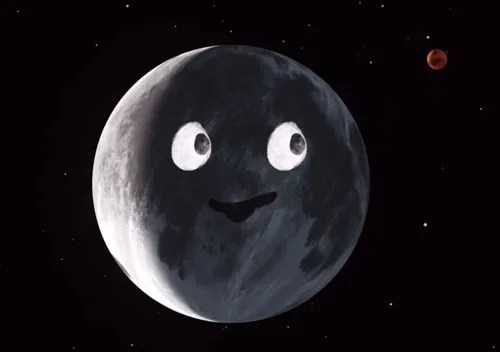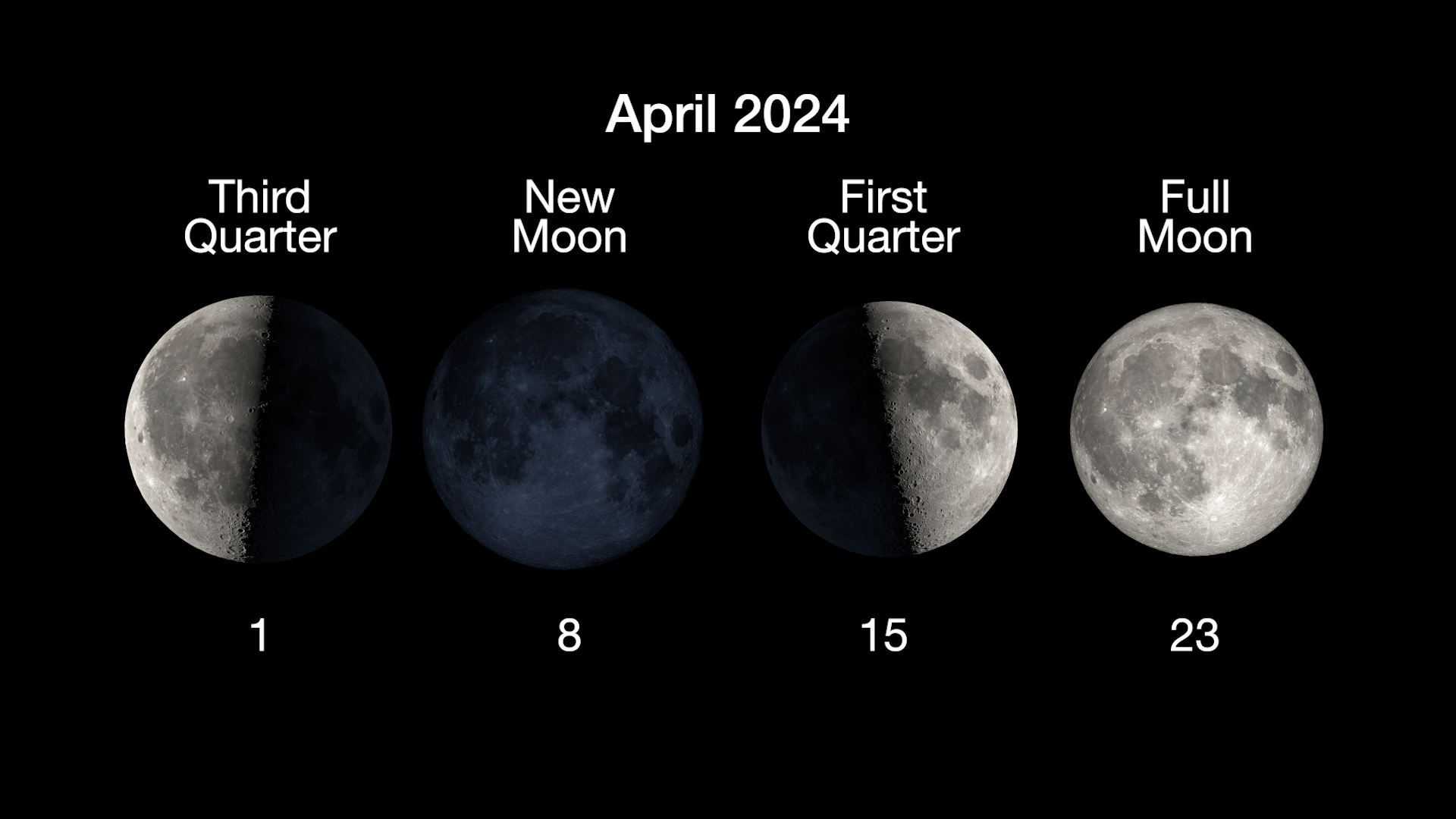17 min read

The Next Full Moon is the Snow Moon, Storm Moon, Hunger Moon, Magha Purnima, Magha Puja, the Mahamuni Pagoda Festival Moon, the Chinese Lantern Festival Moon, and the Full Moon of Tu B'Shevat.
The next full Moon will be early on Sunday morning, Feb. 9, appearing "opposite" the Sun (in Earth based longitude) at 2:33 AM EST. The Moon will appear full for about three days centered around this time, from Friday evening to Monday morning, making this a full Moon weekend.
As the midwinter Moon (the second full Moon of winter) and the full Moon in February, this is the Snow Moon, Storm Moon, or the Hunger Moon. The Maine Farmer's Almanac first published "Indian" names for the full Moons in the 1930's, and according to this almanac, the tribes of what is now the northeastern United States called this the Snow Moon or the Storm Moon because of the heavy snows that fall in this season. The last time I checked, NOAA long-term monthly averages for the Washington, DC area showed January and February nearly tied as the snowiest months of the year. Bad weather and heavy snowstorms made hunting difficult, so this Moon was also called the Hunger Moon. Across North America, there are many different tribes with different languages and different names for the full Moons throughout the year. The most complete list I have found so far has been compiled by Phil Konstantin.
In the Hindu and Buddhist calendars, Magha is the lunar month when the full Moon is in the lunar mansion Magha, which contains the star we call Regulus in English. In the Hindu tradition that ends the months on the full Moon day, this full Moon (purnima) is Magha Purnima, the last day of the Hindu month of Magha. Magha is a month for austerity, performing acts of charity, and ritual bathing at holy river locations (generally where three rivers meet).
For Buddhists, this full Moon corresponds with Magha Puja, the second-most important festival of the year. Magha Puja celebrates a spontaneous gathering of 1,250 of Buddha's first disciples. In Myanmar, this full Moon corresponds with the pagoda festival for the Mahamuni Buddha Temple in Mandalay. The tradition is that only a few likenesses of the Buddha were made during his lifetime, and this temple contains one of them.
In the Chinese and Hebrew lunisolar calendars the months change with the new Moon and full Moons fall in the middle of the lunar months. This full Moon is in the middle of the first month of the Chinese calendar. The 15th day of the first month is the Chinese Lantern Festival, the final day of the traditional Chinese New Year celebrations (see https://en.wikipedia.org/wiki/Lantern_Festival).
This full Moon is in the middle of Shevat in the Hebrew calendar. The 15th day of Shevat is the holiday Tu BiShvat. Tu B'Shevat for the year 2020 is observed on sundown of Sunday, Feb. 9, ending at sundown on Monday, Feb. 10. Tu BiShvat is also called "Rosh HaShanah La'Ilanot" (literally "New Year of the Trees"). In contemporary Israel, the day is celebrated as an ecological awareness day, and trees are planted in celebration.
In the Islamic calendar the months start with the first sighting of the waxing crescent Moon shortly after the New Moon. This full Moon is near the middle of Jumada al-Thani, the sixth month of the Islamic year.
As usual, the wearing of suitably celebratory celestial attire is encouraged in honor of the full Moon.
As for other celestial events between now and the full Moon after next:
Longer Days—and Daylight Savings—Ahead
As winter continues, the daily periods of sunlight continue to lengthen. For the Washington, DC area, on the day of the full Moon (Feb. 9), daylight will last 10 hours, 31 minutes. Morning twilight will begin at 6:08 AM, sunrise will be at 7:07 AM, the Sun will reach a maximum altitude of 36.4 degrees at 12:22:16 PM, sunset will be at 5:38 PM, and evening twilight will end at 6:37 PM, all in EST.
On Sunday, Mar. 8, for most of the USA, we lose an hour as we "spring forward" into daylight savings time , giving us an "extra" hour of sunlight in the evening but shifting the time of sunrise Sunday morning back to later than when sunrise was in late December and early January (2 minutes later for the Washington, DC area). This will not be the latest sunrises of the year. The latest sunrise of 2020 will be on Halloween, just before we "fall back" to standard time.
On the day of the full Moon after next (Mar. 9), the period of daylight will be 71 minutes longer, lasting 11 hours, 42 minutes. Morning twilight will begin at 6:30 AM, sunrise will be at 7:28 AM, the Sun will reach a maximum altitude of 47.0 degrees at 1:18:24 PM, sunset will be at 7:10 PM, and evening twilight will end at 8:07 PM, all in EDT.
On the evening of the full Moon on Feb. 9, as evening twilight ends (at 6:37 PM EST for the Washington, DC area), the brightest of the planets, Venus, will appear in the west-southwest at about 27 degrees above the horizon. Other names for Venus when it is in the evening sky are the Evening Star and Hesperus. The planet Mercury will appear to the lower left of Venus at about 6 degrees above the horizon. The bright star Capella will appear high to the northeast at about 72 degrees above the horizon, while Aldebaran and the other bright stars from the local arm of our home galaxy, including the constellation Orion, will appear spread out towards the southeast. The bright star Regulus will appear near the full Moon.
As the month progresses, Mercury and the background of stars will appear to shift towards the west, while Venus will appear to drift slightly higher in the evening sky towards the east. For the Washington, DC area (and similar latitudes, at least), after Feb. 19, Mercury will have already set by the time evening twilight ends. Mercury will pass between the Earth and the Sun on Feb. 25, and after Mar. 8, will be rising in the east-southeast by the time morning twilight begins. By the full Moon after next on March 9, 2020, we will have switched to Daylight Savings Time.
As evening twilight ends (at 8:07 PM EDT for the Washington, DC area), Venus will appear about 32 degrees above the horizon in the west, the brightest of the stars, Sirius, will appear about 34 degrees above the horizon in the south-southwest, and the other bright stars of the local arm of our home galaxy will appear spread out in the sky.
On the morning of the full Moon on Feb. 9, as morning twilight begins (at 6:08 AM EST for the Washington, DC area), the planet Jupiter will be the brightest planet in the sky, appearing in the southeast at about 8 degrees above the horizon. The planet Saturn will appear next in brightness to the lower left of Jupiter at about 2 degrees above the horizon. Lying roughly in a line with Saturn and Jupiter, the planet Mars will appear to the upper right of Jupiter at about 19 degrees above the horizon.
The bright star appearing nearly overhead will be Arcturus at 66 degrees above the southwestern horizon. As the month progresses, Jupiter, Saturn, and the background of stars will appear to shift towards the west, while Mars will appear in nearly the same part of the sky. For three mornings the Moon will appear near these planets, appearing very close to Mars on Feb. 18, close to Jupiter on Feb. 19, and close to Saturn on Feb. 20, (the spacing between these planets will give you a pretty good idea of how much the Moon shifts in the sky each night).
By March 8, 2020, the planet Mercury will begin appearing just above the horizon in the east-southeast at the time morning twilight begins. By the morning of the full Moon after next on March 9, 2020, at the time morning twilight begins (at 6:30 AM EDT for the Washington, DC area), Saturn, Jupiter, and Mars will appear clustered together in the southeast, with Mercury appearing just on the horizon in the east-southeast. Jupiter will appear brightest at about 16 degrees above the southeastern horizon. Next in brightness will be Saturn, appearing about 13 degrees above the horizon to the left of Jupiter. Mars will appear about 18 degrees above the horizon to the right of Jupiter.
Even though they are not usually visible, I include in these Moon missives information about Near Earth Objects (mostly asteroids) that may pass the Earth within 5 lunar distances, because I find it interesting that we have discovered so many. Sometime between now and the end of the first week in February (2020-Jan-30 08:13 UTC with 9 days, 13 hours, 36 minutes uncertainty), Near Earth Object (2018 AL12), between 29 and 65 meters (96 to 214 feet) in diameter, will pass the Earth at between 2.9 and 80.6 lunar distances (nominally 18.1), traveling at 17.65 kilometers per second (39,490 miles per hour).
On Saturday morning at 11:44 AM EST (2020-Feb-01 16:44 UTC), Near Earth Object (2020 BN12), between 18 and 41 meters (60 to 135 feet) in diameter, will pass the Earth at 3.4 lunar distances, traveling at 6.96 kilometers per second (15,570 miles per hour).
That evening, the Moon will appear half-full as it reaches its first quarter at 8:42 PM EST.
Saturday will be Imolc, and Sunday will be Candlemas and Groundhog's Day. The tradition in some European countries was to leave Christmas decorations up until February 1st, the eve of Candlemas. It was considered bad luck to leave decorations up past Candlemas.
February 2nd is also Groundhog Day, and in the U.S. we have a tradition concerning whether winter will end on Groundhog Day or six weeks later (i.e., around the time of the spring equinox), depending upon whether or not a groundhog sees its shadow.
These traditions appear to tie back to European lore about whether or not a badger, wolves, or a bear (instead of a groundhog) sees its shadow. We currently divide the year into four seasons based upon the solstices and equinoxes, with spring starting on the vernal equinox. This approximates winter as the quarter of the year with the coldest temperatures. Much of pre-Christian northern Europe celebrated "cross-quarter days" halfway between the solstices and equinoxes, and divided the seasons on these days. Using this definition, winter was the quarter of the year with the shortest daily periods of daylight, and spring started on Imbolc in early February.
Many believe that our Groundhog Day and Candlemas traditions tie back to these earlier celebrations of the start of spring (and the confusion caused by having two definitions for the end of winter). Perhaps it was best to let a natural event such as an animal’s shadow decide which definition to use, rather than arguing with your neighbors for the next six weeks...
On Monday night, Feb. 3, at 10:46 PM EST (2020-Feb-04 03:46 UTC), Near Earth Object (2013 BA74), between 21 and 47 meters (69 to 155 feet) in diameter, will pass the Earth at 3.7 lunar distances, traveling at 7.39 kilometers per second (16,520 miles per hour).
Wednesday evening into early Thursday morning, Feb. 3 to 4, the bright star Aldebaran will appear below the waxing gibbous Moon. For the Washington, DC area, evening twilight will end Wednesday at about 6:31 PM, the Moon will reach its highest in the sky for the night at 7:36 PM, and Aldebaran will set in the west-northwest Thursday morning at 2:47 AM EST.
For the Washington, DC area (and similar latitudes at least), Thursday morning, Feb. 4, will be the first morning when the planet Saturn will appear just above the horizon in the east-southeast at the time morning twilight begins.
On Thursday morning, at about 11:51 AM EST (2020-Feb-06 16:51 UTC with 8 minutes uncertainty), Near Earth Object (2020 BF10), between 9 and 21 meters (30 to 68 feet) in diameter, will pass the Earth at between 2.8 and 2.9 lunar distances (nominally 2.8), traveling at 8.57 kilometers per second (19,180 miles per hour).
As mentioned above, the next full Moon will be Sunday morning at 2:33 AM EST.
On Sunday evening, sometime around 8 PM EST (2020-Feb-10 00:49 UTC with 1 hour, 15 minutes uncertainty), Near Earth Object (2020 BK10), between 15 and 34 meters (50 to 112 feet) in diameter, will pass the Earth at 1.9 lunar distances, traveling at 11.45 kilometers per second (25,600 miles per hour).
Also on Sunday evening, the bright star appearing to the right of the full Moon will be Regulus.
On Monday evening, at least for Washington, DC and similar latitudes, the planet Mercury will appear about 6 degrees above the west-southwestern horizon at the time evening twilight ends, its highest for this apparition. For the Washington, DC area, evening twilight will end at 6:38 PM and Mercury will set at 7:10 PM EST.
Monday afternoon, at 3:29 PM EST, the Moon will be at perigee, its closest to the Earth for this orbit.
On Wednesday night into Thursday morning February 12 to 13, 2020, the bright star appearing about 8 degrees below the waning gibbous Moon will be Spica. For the Washington, DC area, Spica will rise in the east-southeast on Wednesday night at about 10:38 PM EST, the Moon will reach its highest for the night on Thursday morning at 4:00 AM, and morning twilight will begin around 6:04 AM.
On Saturday evening, the waning Moon will appear half-full as it reaches its last quarter at 5:17 PM EST.
Sometime around Monday, (2020-Feb-17 19:08 UTC with 1 day, 11 hours, 10 minutes uncertainty), Near Earth Object (2018 CW2), between 21 and 47 meters (69 to 155 feet) in diameter, will pass the Earth at between 1.6 and 13.7 lunar distances (nominally 6.0), traveling at 10.22 kilometers per second (22,860 miles per hour).
On Tuesday morning, the waning crescent Moon and the planet Mars will put on a show, appearing quite close to each other in the southeastern sky. Jupiter and Saturn will add to the show, appearing to the left. The Moon will actually pass in front of Mars, blocking Mars from view, but for the eastern half of the USA this will occur during daylight and will not be visible. For much of the western half of North America, the occultation of Mars by the Moon should be visible, check predictions for your local area.
On Wednesday morning, the bright planet Jupiter will appear to the lower left of the waning crescent Moon. For the Washington, DC area, Jupiter will rise in the east-southeast at about 4:42 AM EST, and the Moon and Jupiter will appear about 12 degrees above the horizon at the time morning twilight begins (5:57 AM), with Mars to the upper right and Saturn to the lower left.
On Thursday morning, the planet Saturn will appear to the upper right of the thin, waning crescent Moon. For the Washington, DC area, the Moon will rise in the east-southeast at around 5:18 AM EST. The Moon and Saturn will be about 6 degrees above the horizon at the time morning twilight begins (5:55 AM), with Jupiter and Mars to the upper right.
Sunday morning at 10:32 AM EST, will be the new Moon, when the Moon passes between the Earth and the Sun and will not be visible from the Earth. The day of or the day after the New Moon usually marks the start of the new month for many lunisolar calendars. The second month of the Chinese calendar starts on Sunday (at midnight in China's time zone, which is 13 hours ahead of EST). Sundown on Tuesday evening, Feb. 25, marks the start of Adar in the Hebrew calendar. In the Islamic calendar the months start with the first sighting of the waxing crescent Moon after the New Moon. Tuesday evening will probably mark the beginning of Rajab, the seventh month of the Islamic year 1441. Rajab is one of the four sacred months in which warfare and fighting are forbidden.
The thin waxing crescent Moon visible a few days after the new Moon in late February and again in late March of 2020 (for the Washington, DC area and similar latitudes, at least) is called a "Wet Moon" or a "Cheshire Moon." This is the season when the thin, waxing crescent Moon appears most like an upward-facing bowl or a smile in the evening sky. According to Wikipedia, the term "Wet Moon" originates from Hawaiian mythology, when the Moon appears like a bowl that could fill up with water. The time of year when this occurs as viewed from the latitudes of the Hawaiian islands roughly corresponds with Kaelo the Water Bearer in Hawaiian astrology. As the year passes into summer, the crescent shape tilts, pouring out the water and causing the summer rains. The term "Cheshire Moon" is a reference to the smile of the Cheshire Cat in Lewis Carroll's Alice's Adventures in Wonderland.
On Tuesday evening, the planet Mercury will pass between the Earth and the Sun as seen from the Earth, called inferior conjunction. Planets that orbit inside of the orbit of Earth can have two types of conjunctions with the Sun, inferior (when passing between the Earth and the Sun) and superior (when passing on the far side of the Sun as seen from the Earth). Mercury will be quickly shifting from the evening sky to the morning sky and will begin emerging from the glow of dawn on the eastern horizon around the end of February (depending upon viewing conditions).
Wednesday, February 26, 2020, at 6:35 AM EST, the Moon will be at apogee, its farthest from the Earth for this orbit.
On Thursday evening, the bright planet Venus will appear in the west-southwest about 7 degrees to the right of the waxing crescent Moon. For the Washington, DC area, they will appear about 31 degrees above the horizon at the time evening twilight ends (6:56 PM EST). Venus will set first in the west-northwest at about 9:39 PM.
On Sunday evening, the bright star Aldebaran will appear about 8 degrees to the upper left of the waxing nearly half-lit Moon.
On Monday afternoon, the Moon will appear half-full as it reaches its first quarter at 2:57 PM EST.
On Monday evening, the bright star Aldebaran will appear to the lower right of the half-lit Moon.
On Thursday evening into Friday morning, the bright star Pollux (one of the twins in the constellation Gemini) will appear near the waxing gibbous Moon. For the Washington, DC area, Pollux will appear to the upper left of the Moon as evening twilight ends on Thursday evening at about 5:03 PM EST. Pollux will appear above the Moon at the time the Moon is highest in the sky for the night (at 9:03 PM), and will appear to the right of the Moon when the Moon sets Friday morning at 4:37 AM.
Saturday evening into Sunday morning, the bright star Regulus will appear below the nearly full waxing gibbous Moon. For the Washington, DC area, evening twilight will end Saturday evening at 7:05 PM EST, the Moon will reach its highest in the sky at 11 PM EST, and morning twilight will begin Sunday morning at 6:32 AM EDT (note change from EST to EDT).
Sunday morning, we "spring forward" into Daylight Savings Time. Don't forget to reset your clocks!
Sometime around the second week in March 2020 (2020-Mar-13 10:23 UTC with 4 days, 15 hours, 31 minutes uncertainty), Near Earth Object (2016 FX13), between 15 and 34 meters (50 to 112 feet) in diameter, will pass the Earth at between 0.4 and 64.3 lunar distances (nominally 30.6), traveling at 12.36 kilometers per second (27,660 miles per hour).
Also sometime around the second or third week in March 2020 (2020-Mar-15 13:29 UTC with 5 days, 3 hours, 46 minutes uncertainty), Near Earth Object (2018 GY), between 29 and 65 meters (96 to 214 feet) in diameter, will pass the Earth at between 3.6 and 26.1 lunar distances (nominally 6.2), traveling at 9.51 kilometers per second (21,270 miles per hour).
The full Moon after next will be on Monday afternoon, March 9, 2020, at 1:48 PM EDT.
Let NASA be your personal guide to the night sky. Our What's Up skywatching page includes daily viewing tips and monthly highlights of the amazing sights to see in your night sky.








